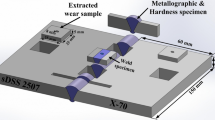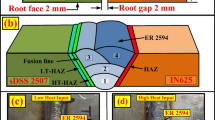Abstract
The present study utilizes a slurry-pot wear tester to investigate the relationship between slurry concentration and slurry-erosion performance of sDSS 2507/IN625 dissimilar weld joint (DWJ). Varying slurry concentrations (10 and 30 wt.% silica sand) were utilized to investigate erosion, weight loss, and wear mechanisms in severe environments. The study aimed to provide an in-depth knowledge of erosion behaviors by analyzing surface characteristics, microstructure characteristics, and material removal mechanisms. The electron probe micro-analyzer studied weld zone element segregation and scanning electron microscopy (SEM) examined microstructure and erosion mechanism. ER2594 filler weld shows higher microhardness as compared to weld fabricated using ERNiCrMo-3 filler metal. Sand particle density, particle-to-surface contact, particle interactions, and fluid impacts increase cumulative weight loss and decrease erosion rate per unit solids weight. Slurry concentration increased weight loss by 23% for sDSS 2507 BM and 33% for IN-625 BM. ER2594-LHI lost 72% and ERNiCrMo-3-LHI 77% more weight with increasing slurry concentration. Filler ERNiCrMo-3 has less erosion wear than filler ER2594 as the concentration of slurry increases. SDSS 2507 BM and IN-625 BM erode 1.45 and 1.8 times faster with increasing slurry concentration, respectively. The erosion rate of ER2594-LHI and ERNiCrMo-3-LHI increases 0.85 and 1.2 times with slurry concentration. SEM analysis of the worn surface exhibits mixed cutting–ploughing modes coexisting with the formation of craters. The material removal has predominantly occurred from the cutting and ploughing mechanism, whereas the characteristic presence of craters and frontal and lateral lips is also found across the entire surface. The results from this study suggest the optimum heat input to be maintained during weld fabrication of sDSS 2507/IN-625 using ER 2594 and ERNiCrMo-3 filler metals for enhanced resistance against slurry erosion wear. Also, an insight into the wear mechanism helps in understanding the effect of microstructural features on the wear performance of welds in operational conditions.











Similar content being viewed by others
Data availability
No data were used for the research described in the article.
References
Javaheri V, Porter D, Kuokkala VT. Slurry erosion of steel—review of tests, mechanisms and materials. Wear. 2018;408–409:248–73. https://doi.org/10.1016/J.WEAR.2018.05.010.
Nguyen QB, Lim CYH, Nguyen VB, Wan YM, Nai B, Zhang YW, et al. Slurry erosion characteristics and erosion mechanisms of stainless steel. Tribol Int. 2014;79:1–7. https://doi.org/10.1016/J.TRIBOINT.2014.05.014.
Levy AV. The platelet mechanism of erosion of ductile metals. Wear. 1986;108:1–21. https://doi.org/10.1016/0043-1648(86)90085-2.
Bews R. Subsea structure demands high-quality GTA pipe welds. Weld J. 2002;81:36–9.
Wijngaarden M, Chater J. Cal energy goes for duplex. Stainl Steel World. 2006;42.
Maurya AK, Kumar N, Chhibber R, Pandey C. Study on microstructure–mechanical integrity of the dissimilar gas tungsten arc weld joint of sDSS 2507/X-70 steels for marine applications. J Mater Sci. 2023. https://doi.org/10.1007/s10853-023-08723-w.
Maurya AK, Pandey SM, Chhibber R, Pandey C. Structure–property relationships and corrosion behavior of laser-welded X-70/UNS S32750 dissimilar joint. Arch Civ Mech Eng. 2023;23:81. https://doi.org/10.1007/s43452-023-00627-5.
Maurya AK, Patnaik A, Pandey SM, Chhibber R, Pandey C. Tribological performance of gas tungsten arc welded dissimilar joints of sDSS 2507/N50 steel. J Mater Eng Perform. 2023. https://doi.org/10.1007/s11665-023-08683-x.
Maurya AK, Pandey C, Chhibber R. Dissimilar welding of duplex stainless steel with Ni alloys: a review. Int J Press Vessels Pip. 2021;192: 104439. https://doi.org/10.1016/j.ijpvp.2021.104439.
Romo SA, Santa JF, Giraldo JE, Toro A. Cavitation and high-velocity slurry erosion resistance of welded Stellite 6 alloy. Tribol Int. 2012;47:16–24. https://doi.org/10.1016/J.TRIBOINT.2011.10.003.
Manisekaran T, Kamaraj M, Sharrif SM, Joshi SV. Slurry erosion studies on surface modified 13Cr-4Ni steels: effect of angle of impingement and particle size. J Mater Eng Perform. 2007;16:567–72. https://doi.org/10.1007/S11665-007-9068-5/FIGURES/10.
López DA, Zapata J, Sepúlveda M, Hoyos E, Toro A. The role of particle size and solids concentration on the transition from moderate to severe slurry wear regimes of ASTM A743 grade CA6NM stainless steel. Tribol Int. 2018;127:96–107. https://doi.org/10.1016/J.TRIBOINT.2018.05.035.
Turenne S, Fiset M, Masounave J. The effect of sand concentration on the erosion of materials by a slurry jet. Wear. 1989;133:95–106. https://doi.org/10.1016/0043-1648(89)90116-6.
Elkholy A. Prediction of abrasion wear for slurry pump materials. Wear. 1983;84:39–49. https://doi.org/10.1016/0043-1648(83)90117-5.
Desale GR, Gandhi BK, Jain SC. Development of correlations for predicting the slurry erosion of ductile materials. J Tribol. 2011. https://doi.org/10.1115/1.4004342/475792.
Dasgupta R, Prasad BK, Jha AK, Modi OP, Das S, Yegneswaran AH. Effects of sand concentration on slurry erosion of steels. Mater Trans JIM. 1998;39:1185–90. https://doi.org/10.2320/matertrans1989.39.1185.
Desale GR, Gandhi BK, Jain SC. Slurry erosion of ductile materials under normal impact condition. Wear. 2008;264:322–30. https://doi.org/10.1016/j.wear.2007.03.022.
Hutchings IM, Winter RE. Particle erosion of ductile metals: a mechanism of material removal. Wear. 1974;27:121–8. https://doi.org/10.1016/0043-1648(74)90091-X.
Lindgren M, Perolainen J. Slurry pot investigation of the influence of erodent characteristics on the erosion resistance of austenitic and duplex stainless steel grades. Wear. 2014;319:38–48. https://doi.org/10.1016/j.wear.2014.07.006.
Agarwal N, Chaudhari GP, Nath SK. Slurry and cavitation erosion of HSLA steel processed by warm multidirectional forging and inter-critical annealing. Tribol Int. 2014;70:18–25. https://doi.org/10.1016/j.triboint.2013.09.017.
Gupta R, Singh SN, Sehadri V. Prediction of uneven wear in a slurry pipeline on the basis of measurements in a pot tester. Wear. 1995;184:169–78. https://doi.org/10.1016/0043-1648(94)06566-7.
Kishor B, Chaudhari GP, Nath SK. Slurry erosion behaviour of thermomechanically treated 16Cr5Ni stainless steel. Tribol Int. 2018;119:411–8. https://doi.org/10.1016/J.TRIBOINT.2017.11.025.
Kishor B, Chaudhari GP, Nath SK. Slurry erosion of thermo-mechanically processed 13Cr4Ni stainless steel. Tribol Int. 2016;93:50–7. https://doi.org/10.1016/j.triboint.2015.08.048.
Singh J, Singh S. Neural network prediction of slurry erosion of heavy-duty pump impeller/casing materials 18Cr-8Ni, 16Cr-10Ni-2Mo, super duplex 24Cr-6Ni-3Mo-N, and grey cast iron. Wear. 2021;476: 203741. https://doi.org/10.1016/j.wear.2021.203741.
Prasad BK, Jha AK, Modi OP, Yegneswaran AH. Effect of sand concentration in the medium and travel distance and speed on the slurry wear response of a zinc-based alloy alumina particle composite. Tribol Lett. 2004;17:301–9. https://doi.org/10.1023/B:TRIL.0000032468.27468.2c.
Javaheri V, Haiko O, Sadeghpour S, Valtonen K, Kömi J, Porter D. On the role of grain size on slurry erosion behavior of a novel medium-carbon, low-alloy pipeline steel after induction hardening. Wear. 2021;476: 203678. https://doi.org/10.1016/j.wear.2021.203678.
Singh J, Vasudev H, Kumar R, Ubaidullah M. Study on wear analysis of Ni–20Al2O3 HVOF micron layers using artificial neural network technique. Int J Interact Design Manuf (IJIDeM). 2023. https://doi.org/10.1007/s12008-023-01433-2.
Liu L, Zhang K, Wang Y, Kong L, Xu Y. Erosion of 38CrMoAlA drilling tool steel in slurry: effect of particle concentration on downhole tool clearance material. J Mater Eng Perform. 2023. https://doi.org/10.1007/s11665-023-08025-x.
Mohan N, Chaudhari G. Mitigating slurry erosion in martensitic stainless steels through boronizing. Mater Today Proc. 2023. https://doi.org/10.1016/j.matpr.2023.09.046.
Singh J, Kumar S, Mohapatra SK. Tribological analysis of WC–10Co–4Cr and Ni–20Cr2O3 coating on stainless steel 304. Wear. 2017;376–377:1105–11. https://doi.org/10.1016/J.WEAR.2017.01.032.
Chung RJ, Jiang J, Pang C, Yu B, Eadie R, Li DY. Erosion–corrosion behaviour of high manganese steel used in slurry pipelines. Wear. 2023;530–531: 204885. https://doi.org/10.1016/j.wear.2023.204885.
AWS., D1. Structural welding code-steel. Mar lin; 1978.
DuPont JN, Marder AR. Thermal efficiency of arc welding processes. Weld J-Incl Weld Res Suppl. 1995;74:406s.
Cotrim-Ferreira FA, Quaglio CL, Peralta RPV, Carvalho PEG, Siqueira DF. ASTM E3-01: standard guide for preparation of metallographic specimens. Braz Oral Res, SciELO Brasil; 2010. p. 438–42.
ASTM E92–17. Standard test methods for Vickers hardness and Knoop hardness of metallic materials. West Conshohocken: ASTM International; 2017. p. 1–27. https://doi.org/10.1520/E0092-17.2.
Maurya AK, Chhibber R, Pandey C. GTAW dissimilar weldment of sDSS 2507 and nickel alloy for marine applications: microstructure-mechanical integrity. Metall Mater Trans A. 2023. https://doi.org/10.1007/s11661-023-07101-0.
Maurya AK, Chhibber R, Pandey C. Studies on residual stresses and structural integrity of the dissimilar gas tungsten arc welded joint of sDSS 2507/Inconel 625 for marine application. J Mater Sci. 2023. https://doi.org/10.1007/s10853-023-08562-9.
Tarodiya R, Gandhi BK. Experimental investigation on slurry erosion behavior of 304L steel, grey cast iron, and high chromium white cast iron. J Tribol. 2019. https://doi.org/10.1115/1.4043903.
De Bree S, Rosenbrand W, De Gee A. On the erosion resistance in water-sand mixtures of steels for application in slurry pipelines. 8th ed. Johannesburg: BHRA Fluid Eng; 1982.
Funding
No funding is received for the work.
Author information
Authors and Affiliations
Corresponding authors
Ethics declarations
Conflict of interest
Author(s) have no conflict of interest.
Ethical approval
The manuscript is original and not submitted elsewhere for publication.
Additional information
Publisher's Note
Springer Nature remains neutral with regard to jurisdictional claims in published maps and institutional affiliations.
Rights and permissions
Springer Nature or its licensor (e.g. a society or other partner) holds exclusive rights to this article under a publishing agreement with the author(s) or other rightsholder(s); author self-archiving of the accepted manuscript version of this article is solely governed by the terms of such publishing agreement and applicable law.
About this article
Cite this article
Maurya, A.K., Khan, W.N., Patnaik, A. et al. Tribological performance of gas tungsten arc welded dissimilar joint of sDSS 2507/IN-625 for marine application. Archiv.Civ.Mech.Eng 24, 23 (2024). https://doi.org/10.1007/s43452-023-00832-2
Received:
Revised:
Accepted:
Published:
DOI: https://doi.org/10.1007/s43452-023-00832-2




